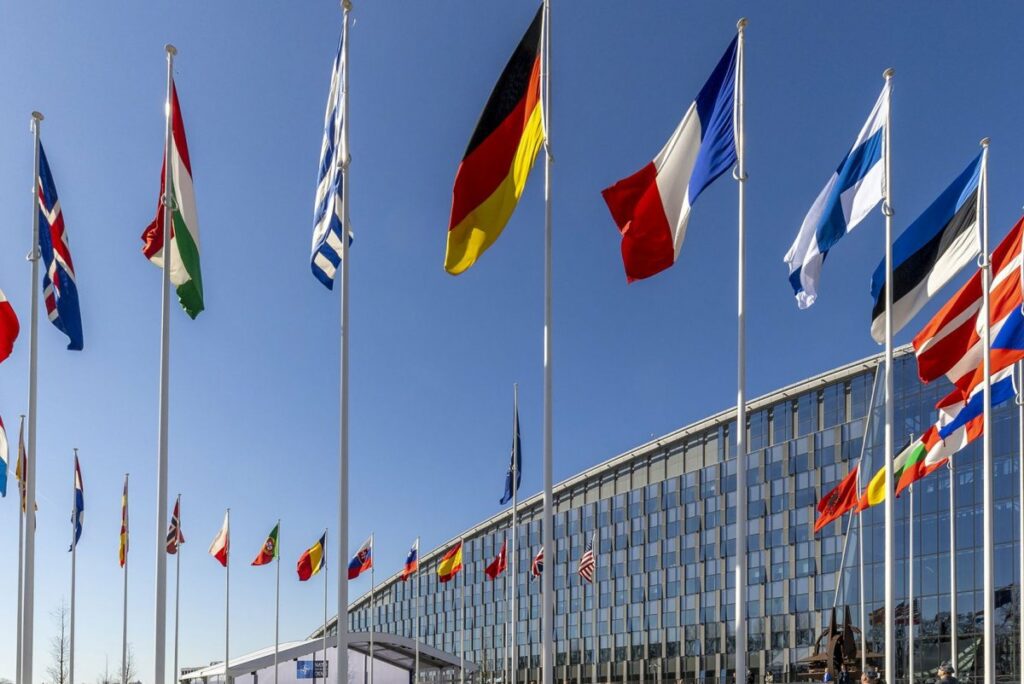Flags fly outside NATO headquarters in Brussels. File Photo by NATO/UPI
June 19 (UPI) — In three weeks, NATO will celebrate its 75th anniversary in Washington, commemorating the signing of the Washington Treaty that created the alliance on April 4th, 1949. During these years, the alliance arguably has been history’s most successful, having won the Cold War peacefully against the Soviet Union, the raison d’être for its establishment.
After the collapse of the Soviet Union, NATO made several transformations responding to the changing international environments. In 2001, NATO went to war for the first time: not to resist a Soviet invasion but instead, the alliance found itself in distant Afghanistan fighting in support of the United States after the attacks of September 11th. NATO’s founding fathers probably would have been in disbelief having learned of this first and only invocation of Article 5 — the alliance’s centerpiece that “an attack against one shall be an attack against all.”
Today, the specter of the Soviet Union is back. NATO now confronts a Russian aggressor following the country’s unprovoked invasion of Ukraine in 2022. NATO’s coherence and unity have been greatly strengthened by Moscow’s belligerence. NATO has rallied to support Ukraine. However, less visible gaps and tensions lurk between both sides of the Atlantic and the United States and its thirty European allies. Canada of course is not in Europe.
Of the least visible and perhaps most significant are the economic disparities between America and its allies. U.S. GDP is about $25 trillion with a population of about 340 million. Europe and Canada have a total GDP of $20 trillion and 620 million citizens. But the U.S. economy is miles ahead of the rest of NATO’s with little sign of that gap closing for the foreseeable future.
Why is this important? For most of its history, the United States has been pleading or urging the allies to spend more on defense. Currently, 23 of 32 members spend the minimum of 2% of GDP on defense. The US spends just over 3%.
Former president Donald Trump has repeatedly demanded the allies spend more on defense, questioning if the United States would aid those allies not paying their fair share if war arose. Most European members of the alliance worry or fear how Trump would react if re-elected president, especially given his positive and even admiring views of Vladimir Putin.
Of those U.S. European ambassadors with whom I have spoken, Trump and NATO is a leading topic of conversation. And this is not a casual issue. Given his past record and so-called America First policies, Trump has given no guarantees of absolute support for NATO as President Joe Biden has.
Unfortunately, percent of GDP spent on defense has become a political measure of commitment to the alliance. Rationally, that does not make sense. Total NATO GDP is about $45 trillion. Its combined population is about 950 million. NATO spends a total of about $1.3 trillion on defense (the United States about $890 billion).
Russian GDP is about $2.3 trillion with a shrinking population of about 143 million. Russia spends about $100 billion on defense and using purchasing power, it may be a bit more. Statistically, there are no comparisons — NATO spends ten times more on defense than Russia.
Similarly, with the exception of non-strategic or tactical nuclear weapons, in every category of weapons from troops to tanks, fighter aircraft, ships and artillery, Russia is overwhelmed by NATO. Further, Russia has taken staggering losses in Ukraine that by some estimates are in excess of 500,000 casualties to its forces. Yet, politics are forcing NATO to spend more on defense.
Given the huge economic disparities between both sides of the Atlantic, it is more difficult for these European members to increase defense spending substantially, even at 1% of GDP. And in the United States, while the drumbeat for more defense spending is building, a deficit approaching $35 trillion surely will impose some limits on increases given that social program costs are also rapidly escalating.
What can be done? Given the staggering disparities between NATO and Russia in terms of measures of defense, surely current resources must be more than sufficient. Using the Ukraine War as a measure for example, if NATO were to adopt a strategy such as a Porcupine Defense in which the aim was to so disrupt any initial attack to make it too costly, that would be more affordable and effective. This summit is the place to do that.
The question is whether NATO will conduct this critical self-examination or just call for more spending that may not solve these issues.
Harlan Ullman is UPI’s Arnaud de Borchgrave Distinguished Columnist, a senior adviser at Washington’s Atlantic Council, the prime author of “shock and awe” and author of “The Fifth Horseman and the New MAD: How Massive Attacks of Disruption Became the Looming Existential Danger to a Divided Nation and the World at Large.” Follow him @harlankullman. The views and opinions expressed in this commentary are solely those of the author.
Source link : https://www.upi.com/amp/Voices/2024/06/19/gaps-united-states-nato-europe-russia/6651718800077/
Author :
Publish date : 2024-06-19 09:14:06
Copyright for syndicated content belongs to the linked Source.
